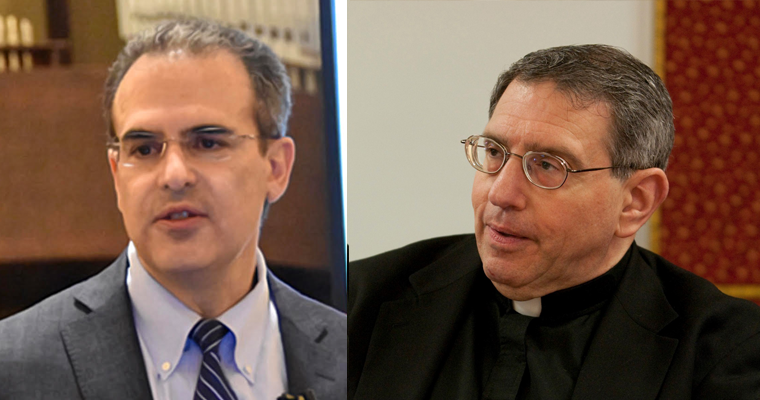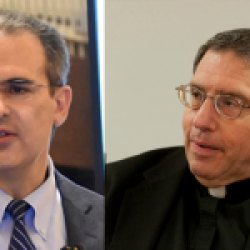Dr. Paul Fiacco and Father Charles Vavonese. (Photos provided)
By Dr. Paul Fiacco and Father Charles Vavonese | Special to the Catholic Sun
Editor’s note: This is one in a series of articles that will explain and explore the Church’s teachings on end-of-life and palliative care issues.
Dr. Paul Fiacco is the president and medical director of CNY AIM, a St. Joseph Health clinically integrated network, and is also the medical director of the Trinity Health Integrated Care ACO as well as full-time family physician at CNY Family Care in East Syracuse. He is a parishioner at Holy Cross Church in DeWitt.
Father Charles Vavonese is a retired priest of the Diocese of Syracuse and the author of “I am the Resurrection and the Life,” a resource booklet dealing with end-of-life moral issues, no longer in print. He currently serves patients receiving palliative care as the chaplain for the St. Joseph Health Mobile Integrated Services Team. In addition, Father Vavonese is a weekend assistant at Holy Cross Church in DeWitt.
The previous article discussed two contexts in which “quality of life” is used in end-of-life discussions. The first is when a patient with a serious condition decides to forgo or withdraw a treatment that is considered extraordinary care or excessively burdensome in favor of enjoying the remainder of life in a comfortable manner. This decision is permissible in Catholic theology. In the second situation the diminished “quality of life” of the person who has a disability or who is seriously ill is used by some to justify terminating lives by those who propose euthanasia or assisted suicide, which are never permissible in Catholic moral teaching.
Pain management
One of the many concerns for terminal patients at the end of their lives is the management of pain. Our Church’s tradition is clear that “Patients should be kept as free of pain as possible…. Medicines capable of alleviating or suppressing pain may be given to a dying person, even if this therapy may indirectly shorten the person’s life so long as the intent is not to hasten death” (Ethical and Religious Directives for Catholic Health Care Services #61, 2018). Many individuals find this confusing since it appears to be in conflict with other Catholic end-of-life moral teachings.
Principle of double effect
The administration of medication for pain in these circumstances is permitted in Catholic theology by using the principle of double effect developed by St. Thomas Aquinas, a medieval theologian. St. Thomas developed this schema for resolving dilemmas that occur when a single action has both a “good” outcome and a “bad” outcome. According to Aquinas’ analysis, for an action with both a “good” and a “bad” outcome to be morally acceptable, all of the following criteria must be met: 1) the nature of the act must be morally good or at least neutral; 2) the intention of the action must be to achieve the good effect, not the bad effect; 3) the bad effect must not be the means to bring about the good effect; and 4) there must be a proportionate reason to justify or tolerate the bad effect.
The principle of double effect can be applied to a situation where the administration of pain medication to terminal patients may indirectly shorten their lives. First, in our example, the use of medications to relieve pain is a morally “good” action. Second, the relief of pain is the intended outcome, not the shortening of the patient’s life. Third, the shortening of the patient’s life — or even his or her death (bad effect) — is not the means by which pain is relieved (good effect). (Note: One of the moral difficulties with assisted suicide and euthanasia is that they fail this aspect of the principle of double effect — death IS the means by which the patient’s pain is “relieved.”) Finally, the “good” effect of sparing the terminal patient pain provides sufficient proportionate reason to justify or tolerate the possible shortening of his or her life.
Since in this analysis all of Aquinas’ criteria have been met, the administration of pain medication to a dying patient is a morally acceptable choice even though it may have the unintended but foreknown effect of shortening the patient’s life.
Summary
This article applied the principle of double effect developed by St. Thomas Aquinas to a common end-of-life situation. The Catholic tradition maintains that it is permissible to offer, and even to increase if necessary, a patient’s pain medication even if this may have the effect of shortening his or her life. For this and all end-of-life decisions, it is best to get the counsel of a priest or other person knowledgeable in Catholic health care ethics.
Next article
The next article will deal with the administration of medically assisted food and hydration for those who cannot take food orally.





